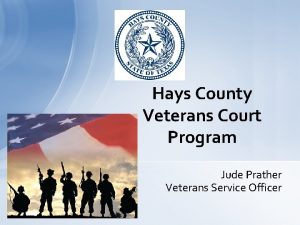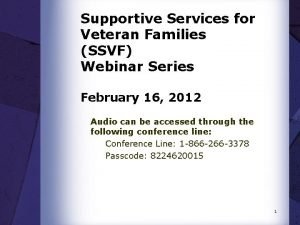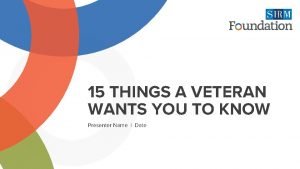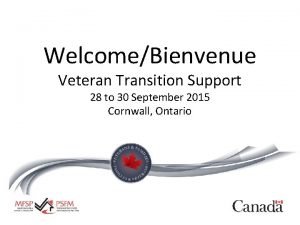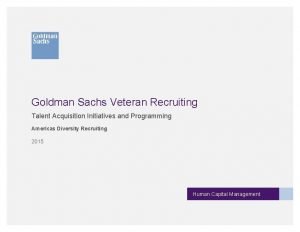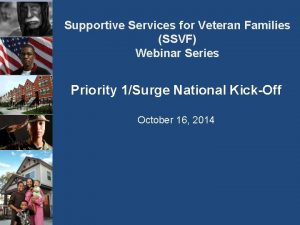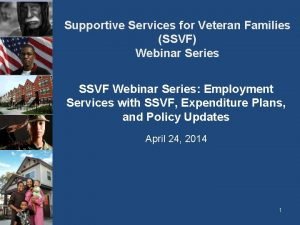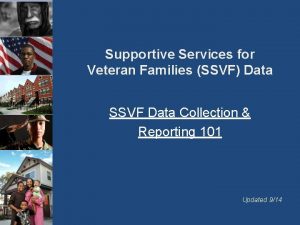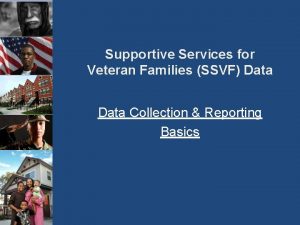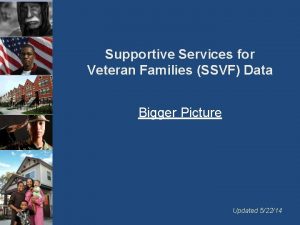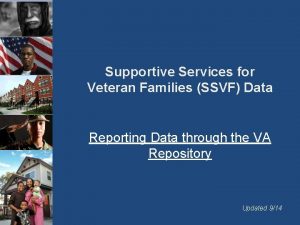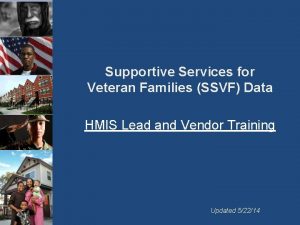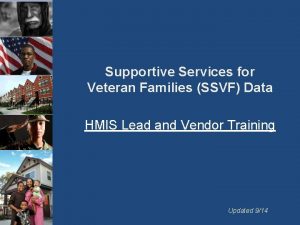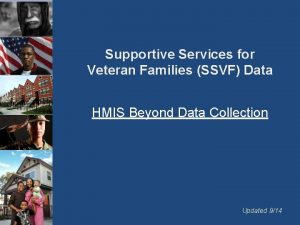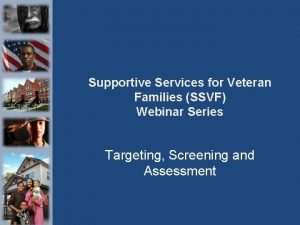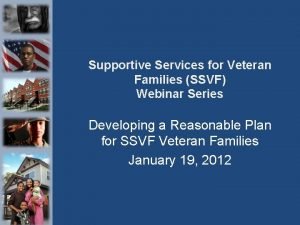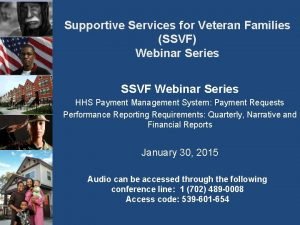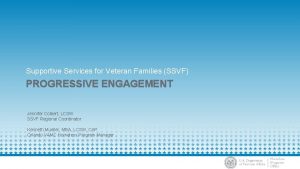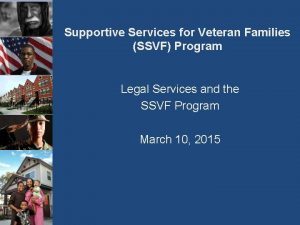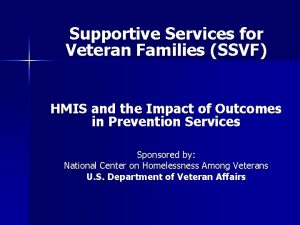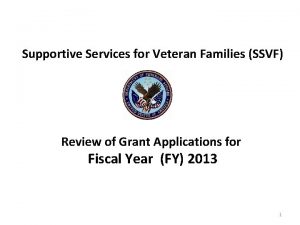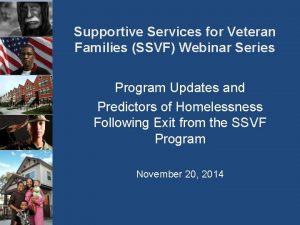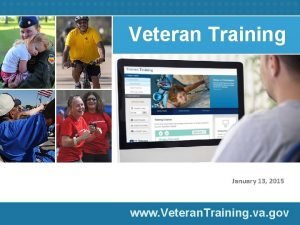Supportive Services for Veteran Families SSVF Data Collection


















































- Slides: 50

Supportive Services for Veteran Families (SSVF) Data Collection & Reporting: Basics Updated 5/22/14

Session Topics • • • About HMIS Roles and Responsibilities HMIS Set-up Process Data Collection Requirements Reporting Requirements Tools and Resources for new grantees 2

What is HMIS? A Homeless Management Information System (HMIS) is a community-based software application that collects and reports on client-level information about the characteristics and needs of people who are served by programs intended to prevent and end homelessness 3

Homelessness Data Before HMIS • Estimates of the numbers of homeless people locally, regionally, and nationally varied widely • Programs filed paper reports with counts of people served, often based on paper records • Communities conducted point-in-time counts but there was no way to get an unduplicated count of people at the community level over time • There was no reliable way to assess the effectiveness of homeless programs 4

Goals of HMIS • Measure the effectiveness of programs • Generate an unduplicated count of homeless persons for each Continuum of Care (Co. C) • Help understand the extent and nature of homelessness locally, regionally, and nationally • Understand patterns of service use 5

VA Participation in HMIS • The utility of HMIS data at the local level depends on participation by all programs that serve people who are homeless and at risk of homelessness, regardless of funding source • VA is committed to grantee participation in HMIS to support community-based service planning and coordination for Veterans who are homeless and at risk of homelessness 6

SSVF and HMIS • SSVF Requirements: – Participate in your local HMIS – Required to export HMIS data monthly and upload into VA Repository • Work with your local HMIS to get your SSVF program set up • Technical assistance is available to your program, your HMIS, and the HMIS vendor 7

Local HMIS Requirements • SSVF programs are participating in local HMIS implementations • A local HMIS may have additional requirements • Communicate with your local HMIS administrator to be sure that you understand local requirements • If local requirements conflict with SSVF program requirements, contact your regional coordinator to seek technical assistance 8

Grantee Roles and Responsibilities: The SSVF Grantee is responsible for all activity associated with agency staff and use of the HMIS – – – Co. C Participation HMIS Participation and Governance Compliance Privacy and Security Compliance HMIS Policy and Procedure Compliance Data Quality Compliance Community Planning/Use of Data 9

Grantee Roles and Responsibilities: • Co. C Participation – Attend/Participate regularly in Co. C meetings and workgroups – Represent Veteran population in planning process – Improve coordination with other service providers – Increase awareness of homeless Veteran needs – Identify additional resources for homeless Veterans • HMIS Participation and Governance Compliance – HMIS Agency Participation Agreement – HMIS End user Agreements – Client Consent 10

Grantee Roles and Responsibilities: • Privacy and Security Compliance – Know HMIS Privacy and Security requirements – Communicate HMIS Privacy and Security requirements to data custodians and system users – Regularly monitor for compliance • HMIS Policy and Procedure Compliance – Establish business controls and practices to ensure compliance to HMIS policies – Communicate HMIS policy and procedure requirements to data custodians and system users – Monitor compliance and periodically review business controls and practices for effectiveness 11

Grantee Roles and Responsibilities: • Data Quality Compliance – Know Data Quality expectations for timeliness, completeness, and accuracy – Communicate Data Quality expectations to end users – Monitor for compliance • Community Planning/ Use of Data – Provide quality data for community planning – Actively participate in planning process – Provide data on program characteristics (Program Descriptors) for HMIS and Co. C program inventory and reporting purposes 12

HMIS System Administrator Each HMIS implementation designates a system administrator to provide day-to-day management and support to the HMIS project • Program set up guidance • Training and technical assistance support • Oversight and monitoring of HMIS operations • Management of HMIS documentation, including client consent, privacy and security practices, and other policy and procedures 13

HMIS System Administrator Contact your local System Administrator to identify the locally specific HMIS participation requirements: • Training, certifications, fees, participation standards, monitoring expectations • Assistance with monthly data uploads to the VA Repository • Local system administrators are likely to be your initial resource for TA and support 14

HMIS Software Solution Provider • Software solution provider is the company that created and/or services the software your HMIS uses • There are many different software solution providers. Each may play a slightly different role in each community • Solution providers often release general product use documentation that may be very helpful for SSVF program staff. 15

Co. C Staff The Co. C addresses homelessness for a defined geographic region through coordinated planning, funding, and management of homeless assistance resources • Coordinates system of housing and services to address homeless needs • Designates a HMIS to track the extent of homelessness and measure program effectiveness • Establishes strategic plan for the Co. C 16

SSVF Data in Context National SSVF Program Your SSVF Program Local Continuum of Care Client 17

Quiz Whose primary responsibility is it to ensure compliance with HMIS data quality and privacy and security requirements? 18

Answer • You! The grantee is responsible for maintaining compliance with data quality standards, as well as privacy and security requirements. 19

Co. C Staff Co. C may operate the HMIS or may designate/ authorize a HMIS lead agency to perform the following: § Establish HMIS participation guidelines and expectations § Establish privacy protections for client data entered into HMIS § Establish security protections to create safe and secure HMIS operating environments § Monitor and enforce compliance with participation requirements 20

Goals of SSVF Data Collection • Produce an unduplicated count of Veterans and household members served by the SSVF program nationally • Understand the characteristics of Veterans who are homeless or at risk of homelessness • Identify which other VA-funded services SSVF clients may be accessing • Measure the effectiveness of the SSVF program 21

Data Flow • SSVF grantees enter program data into local HMIS application • Every month, SSVF data is exported from HMIS and uploaded to VA Repository • National-level reporting is generated based on uploaded data HMIS 2 HMIS 1 HMIS 3 VA Repository 22

Data Collected in HMIS • • Who are your clients? When did you serve them? What are their characteristics? What are their circumstances at the time they enter your program? • Do they have any special needs? • What services are you providing? • Did their circumstances change while in your program? Reference: SSVF Data Collection Template, 2010 Revised HMIS Data Standards 23

Who Are Your Clients? 100% of your records in HMIS must include: • Name • Social Security number • Date of birth 24

When Did You Serve Them? These data elements are required: • Program entry date • Program exit date • Dates on service records 25

What Are Their Characteristics? Required for each client record: • Race • Ethnicity • Gender Required for each program entry • Veteran status (adults only) • Disabling condition 26

What Are Their Circumstances When They Enter Your Program? Required at each program entry: • Residence prior to program entry (adults only) • ZIP code of last permanent address (adults only) • Housing status • Income and sources • Non-cash benefits 27

Do They Have Any Special Needs? These data elements are optional: • Physical Disability • Developmental Disability • Chronic Health Condition • HIV / AIDS* • Mental Health • Substance Abuse* • Domestic Violence 28

What Services Are You Providing? These data elements are required for each service provided when it is provided: • Financial Assistance Provided • Housing Relocation & Stabilization Services Provided This data element is optional: • Services Provided 29

Did Their Circumstances Change While In Your Program? These data elements are required at program exit: • Destination • Housing status • Income and sources* • Non-cash benefits* *Also collected at least once annually for clients who are in your program for more than one year 30

Special Issues for Special Needs • Information about specific disabilities is collected as clients enter the program, at least once per year while they are enrolled, and at program exit • If you collect data related to HIV/AIDS or substance abuse for SSVF and enter it into HMIS, that data may not be shared with other organizations • If your HMIS doesn’t allow keeping HIV/AIDS and substance abuse data private, don’t enter it into HMIS 31

HMIS Data Collection for those with history of domestic violence • Programs whose primary mission is to serve victims of DV are prohibited from entering client data into HMIS (per VAWA). • All other SSVF grantees are required to collect and enter data into HMIS for 100% of participants. • Contact Regional Coordinator if SSVF requirement appears to be in conflict with state, local law or local HMIS policy. 32

Data Reporting Requirements • Repository upload: – Upload of client and program level data to a secure SSVF Repository managed by the VA – Uploaded anytime between the 1 st and 5 th business days of each month – Each upload contains a data set reflecting program activity from program inception to the date of export – See VA Data Guide for more detailed instructions on the upload process • Cover sheet: – SSVF grantees must submit a monthly coversheet to their Regional Coordinator by the 5 th business day of the following month. – Purpose is to collect information on the data elements that are currently not required in HMIS by the 2010 HMIS Data Standards. • Quarterly Reports: – Complete quarterly reports addressing programmatic and financial information. – For more information, see VA Web site at: http: //www. va. gov/homeless/ssvfuniversity. asp? page=/program_requirements/reporting 33

What Is Data Quality? • Data Quality indicators – Timeliness – Completeness – Accuracy • Data Quality processes – Monitoring – Incentives and enforcement

Quiz! Which of the following are NOT required data elements at program entry? a) b) c) d) Housing Status Residence Prior to Program Entry Income and Sources Mental Health 35

Answer • Mental Health is an optional data element • The other elements noted below are required and very important data to collect: – Housing Status – Residence Prior to Program Entry – Income and Sources 36

Data Quality Requirements • Data collection and HMIS data entry is mandatory for SSVF Grantees • Data is uploaded to the VA SSVF Repository during the first 5 business days of each month • Uploads are rejected if data quality is below thresholds 37

Data Quality Benefits • Ensures target population is being served and services are being tracked • Enables grant activity monitoring and performance measurement • Informs program planning and potential for midcourse corrections or adjustments *Note: Data provided to VA is cumulative – ‘bad data’ does not go away until it is corrected in the HMIS 38

Data Quality Monitoring: Data Quality Alerts • There are three types of data quality error for SSVF data: Data Quality Alerts, Validation Errors and File Errors. • At the Data Quality Alert level, users are alerted to potential data quality issues, but the Repository will accept the upload. – For example, if any client record is missing a last name, the user will be notified. • Grantees are strongly encouraged to correct issues at the Data Quality level. Even if the Repository does not reject the upload, missing data at this level is a problem. 39

Data Quality Monitoring File & Validation Errors Any errors listed as a Validation or File error will cause the Repository to reject the uploaded data set. For example, if more than 10% of client records are missing a last name, the upload will be rejected. 40

Identifying and Correcting Errors • If your data is rejected, update the records in HMIS to correct missing data – If you do not have the resources to identify which records are missing data, technical assistance is available • Once issues are resolved in HMIS, a new export file should be created and uploaded to the Repository • Resolving issues may take some time – upload to the Repository as early as possible each month to allow extra time to make corrections and resubmit data 41

Planning and HMIS Set-up • SSVF grantees should be contacting the Co. C(s) and HMIS staff now – Negotiate and execute agreements – Start HMIS training, including data collection and privacy and security training – Work with HMIS staff for data entry needs • Consider that the SSVF Grant may cover multiple Co. C jurisdictions. Where will data be entered? • Will subgrantees enter data directly into HMIS? • Request individual logon and passwords for all Repository users, including back-up staff.

Planning and HMIS Set-up • Establish and test data collection workflow and tools • Determine HMIS reporting capabilities • Determine who will upload data to the VA Repository: • Preferred method: HMIS Administrator will upload • Alternative: Grantee will manage the upload process • Caution: The Grantee is ultimately responsible for complete, accurate and timely uploads to the Repository – even if the HMIS Lead Agency agrees to manage the upload process!

Basic Steps and Sequencing for Implementation Set-up – Develop intake forms that capture required VA SSVF information – Develop the SSVF workflow – Establish data collection and entry policies and procedures – Train staff 44

Basic Steps and Sequencing for Implementation Set-up – Establish management and end user accountability for data accuracy, timeliness and completeness – Train SSVF staff to consistently collect and record all required information per policies/procedures and workflow – Test data entry using HMIS training database – Confirm that HMIS can produce all information needed for monthly and quarterly VA reporting 45

Basic Steps and Sequencing for Implementation Data Collection and Entry – Supervise client data collection and entry – Include regular data monitoring as part of the data collection and entry process to assure that information is timely, complete and accurate – Provide feedback and additional training, as necessary, to data entry staff 46

Basic Steps and Sequencing for Implementation Before Exporting Data From HMIS – Confirm that all information for the calendar month has been entered into HMIS – Use any available data quality tools to check for missing or erroneous data prior to the end of each month and update records in HMIS 47

Basic Steps and Sequencing for Implementation Upload to the Repository – Make sure that your data is uploaded to the Repository BEFORE the last day of the upload cycle (the fifth business day of the month) – If data is rejected, correct errors and resubmit data to the Repository BEFORE the Repository closes – Data may be resubmitted at anytime during the five day window – only the most recent successful upload will be stored in the Repository 48

Other Resources • SSVF Data Guide http: //www. va. gov/homeless/ssvfuniversity. asp? page=/pr ogram_requirements/hmis_and_data • 2010 HMIS Data Standards https: //www. onecpd. info/resource/1190/hmis-datastandards-2010 -revised-notice/ • HUD One. CPD Resource Exchange https: //www. onecpd. info/ 49

Questions? Contact ssvfhmis@abtassoc. com 50
 Hays county district clerk
Hays county district clerk Ssvf legal services
Ssvf legal services Big families vs small families
Big families vs small families 15 things every veteran wants you to know
15 things every veteran wants you to know Veteran transition academy
Veteran transition academy Goldman sachs veterans integration program
Goldman sachs veterans integration program Veteran market segmentation
Veteran market segmentation Schedule a hiring authority 5 cfr 213,3102(u)
Schedule a hiring authority 5 cfr 213,3102(u) Indiana disabled veteran license plate
Indiana disabled veteran license plate Weyth
Weyth Ssvf university
Ssvf university Ssvf university webinars
Ssvf university webinars Landsat collection 1 vs collection 2
Landsat collection 1 vs collection 2 Documentary payment
Documentary payment Procedures of data collection
Procedures of data collection The terms external secondary data and syndicated
The terms external secondary data and syndicated Iso 22301 utbildning
Iso 22301 utbildning Typiska drag för en novell
Typiska drag för en novell Nationell inriktning för artificiell intelligens
Nationell inriktning för artificiell intelligens Returpilarna
Returpilarna Varför kallas perioden 1918-1939 för mellankrigstiden?
Varför kallas perioden 1918-1939 för mellankrigstiden? En lathund för arbete med kontinuitetshantering
En lathund för arbete med kontinuitetshantering Underlag för särskild löneskatt på pensionskostnader
Underlag för särskild löneskatt på pensionskostnader Tidböcker
Tidböcker A gastrica
A gastrica Vad är densitet
Vad är densitet Datorkunskap för nybörjare
Datorkunskap för nybörjare Tack för att ni lyssnade bild
Tack för att ni lyssnade bild Mall för debattartikel
Mall för debattartikel Delegerande ledarstil
Delegerande ledarstil Nyckelkompetenser för livslångt lärande
Nyckelkompetenser för livslångt lärande Påbyggnader för flakfordon
Påbyggnader för flakfordon Kraft per area
Kraft per area Svenskt ramverk för digital samverkan
Svenskt ramverk för digital samverkan Kyssande vind analys
Kyssande vind analys Presentera för publik crossboss
Presentera för publik crossboss Argument för teckenspråk som minoritetsspråk
Argument för teckenspråk som minoritetsspråk Kanaans land
Kanaans land Klassificeringsstruktur för kommunala verksamheter
Klassificeringsstruktur för kommunala verksamheter Luftstrupen för medicinare
Luftstrupen för medicinare Claes martinsson
Claes martinsson Centrum för kunskap och säkerhet
Centrum för kunskap och säkerhet Lågenergihus nyproduktion
Lågenergihus nyproduktion Mat för unga idrottare
Mat för unga idrottare Verktyg för automatisering av utbetalningar
Verktyg för automatisering av utbetalningar Rutin för avvikelsehantering
Rutin för avvikelsehantering Smärtskolan kunskap för livet
Smärtskolan kunskap för livet Ministerstyre för och nackdelar
Ministerstyre för och nackdelar Tack för att ni har lyssnat
Tack för att ni har lyssnat Referatmarkeringar
Referatmarkeringar Redogör för vad psykologi är
Redogör för vad psykologi är
